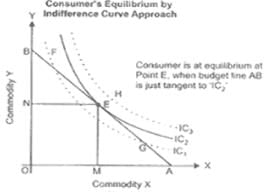Humanities/Arts Exam > Humanities/Arts Questions > Expalin the conditions of consumers equilibri...
Start Learning for Free
Expalin the conditions of consumers equilibrium with the help of indifference curve analysis?
Verified Answer
Expalin the conditions of consumers equilibrium with the help of indif...
Consumer equilibrium refers to a situation, in which a consumer derives maximum satisfaction, with no intention to change it and subject to given prices and his given income. The point of maximum satisfaction is achieved by studying indifference map and budget line together. On an indifference map, higher indifference curve represents a higher level of satisfaction than any lower indifference curve. So, a consumer always tries to remain at the highest possible indifference curve, subject to his budget constraint.
Conditions of Consumer’s Equilibrium:
The consumer’s equilibrium under the indifference curve theory must meet the following two conditions:
(i) MRSXY = Ratio of prices or PX/PY:
Let the two goods be X and Y. The first condition for consumer’s equilibrium is that
MRSXY = PX/PY
(a) If MRSXY > PX/PY, it means that the consumer is willing to pay more for X than the price prevailing in the market. As a result, the consumer buys more of X. As a result, MRS falls till it becomes equal to the ratio of prices and the equilibrium is established.
(b). If MRSXY < PX/PY, it means that the consumer is willing to pay less for X than the price prevailing in the market. It induces the consumer to buys less of X and more of Y. As a result, MRS rises till it becomes equal to the ratio of prices and the equilibrium is established.
(ii) MRS continuously falls:
The second condition for consumer’s equilibrium is that MRS must be diminishing at the point of equilibrium, i.e. the indifference curve must be convex to the origin at the point of equilibrium. Unless MRS continuously falls, the equilibrium cannot be established.
Thus, both the conditions need to be fulfilled for a consumer to be in equilibrium.

In Fig, IC1, IC2 and IC3 are the three indifference curves and AB is the budget line. With the constraint of budget line, the highest indifference curve, which a consumer can reach, is IC2. The budget line is tangent to indifference curve IC2 at point ‘E’. This is the point of consumer equilibrium, where the consumer purchases OM quantity of commodity ‘X’ and ON quantity of commodity ‘Y. All other points on the budget line to the left or right of point ‘E’ will lie on lower indifference curves and thus indicate a lower level of satisfaction.Thus, we can conclude that if the consumer is consuming any bundle other than the optimum one, then he would rearrange his consumption bundle in such a manner that the equality between the MRS and the price ratio is established and he attains the state of equilibrium.
 This question is part of UPSC exam. View all Humanities/Arts courses
This question is part of UPSC exam. View all Humanities/Arts courses

|
Explore Courses for Humanities/Arts exam
|

|
Similar Humanities/Arts Doubts
Expalin the conditions of consumers equilibrium with the help of indifference curve analysis?
Question Description
Expalin the conditions of consumers equilibrium with the help of indifference curve analysis? for Humanities/Arts 2025 is part of Humanities/Arts preparation. The Question and answers have been prepared according to the Humanities/Arts exam syllabus. Information about Expalin the conditions of consumers equilibrium with the help of indifference curve analysis? covers all topics & solutions for Humanities/Arts 2025 Exam. Find important definitions, questions, meanings, examples, exercises and tests below for Expalin the conditions of consumers equilibrium with the help of indifference curve analysis?.
Expalin the conditions of consumers equilibrium with the help of indifference curve analysis? for Humanities/Arts 2025 is part of Humanities/Arts preparation. The Question and answers have been prepared according to the Humanities/Arts exam syllabus. Information about Expalin the conditions of consumers equilibrium with the help of indifference curve analysis? covers all topics & solutions for Humanities/Arts 2025 Exam. Find important definitions, questions, meanings, examples, exercises and tests below for Expalin the conditions of consumers equilibrium with the help of indifference curve analysis?.
Solutions for Expalin the conditions of consumers equilibrium with the help of indifference curve analysis? in English & in Hindi are available as part of our courses for Humanities/Arts.
Download more important topics, notes, lectures and mock test series for Humanities/Arts Exam by signing up for free.
Here you can find the meaning of Expalin the conditions of consumers equilibrium with the help of indifference curve analysis? defined & explained in the simplest way possible. Besides giving the explanation of
Expalin the conditions of consumers equilibrium with the help of indifference curve analysis?, a detailed solution for Expalin the conditions of consumers equilibrium with the help of indifference curve analysis? has been provided alongside types of Expalin the conditions of consumers equilibrium with the help of indifference curve analysis? theory, EduRev gives you an
ample number of questions to practice Expalin the conditions of consumers equilibrium with the help of indifference curve analysis? tests, examples and also practice Humanities/Arts tests.

|
Explore Courses for Humanities/Arts exam
|

|
Signup for Free!
Signup to see your scores go up within 7 days! Learn & Practice with 1000+ FREE Notes, Videos & Tests.
























